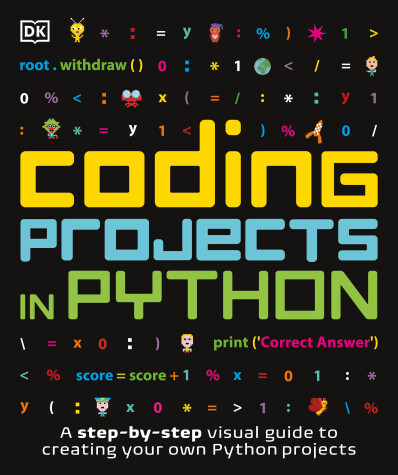Reviewed by annieb123 on
A new how-to from DK Publishing mostly aimed at the younger audience (10+) but perfectly usable for anyone who needs a good introduction to syntax and programming in Python.
DK are experts at well illustrated how-to books and this one is no exception.
Fairly hefty at 224 pages, this is a thorough introduction to Python. The examples are very well laid out with multiple real-life illustrations and screenshots. The graphics are lively and colorful and so much more interesting than the average doorstop sized coma-inducing boring snoozefest. This book is quite fun to read. Syntax and code are introduced gradually and build on earlier content. One thing I really liked about this book is that instead of just telling the reader what to do, it explains clearly why to do things and what effects result from which logical statements.
This book presupposes nothing. It begins introducing very basic concepts (what is a computer language, why program, what bugs are) and moves on to how to install (and that younger users should get permission before installing anything on their platform).
The book is full of sidebars with tips and tricks and pitfalls to avoid as well as good debugging information to minimize frustration.
The post-installation parts introduce the shell and working with test code and the difference between the shell and editor. The second chapter moves on to talk about flowcharts and writing a simple program. Each chapter also introduces terms and concepts used in the programming exercises for that chapter; for example, variables, lists, and strings are introduced defined and used in chapter 2.
Chapter 3 introduces graphics and provides several fun exercises for programming graphics.
At the end of each chapter, the material is reviewed with additional 'Hacks and Tweaks' allowing further experimentation and improvement. There's a graphic robot builder and a kaleidoscope spirograph type exercise among others.
Chapter 4 moves to app writing and self contained programming for different devices and platforms. As with the rest of the book, all of the different exercises are completely illustrated and supported with accessible, easily understood text and pictures.
Chapter 5 continues to build on the previous content with more complex games such as Snap! and concentration matching games. As always there are sidebars with tips and a section for tweaking and improving the programs.
There is a reference chapter at the end which is accessible and usable. Code references for all of the projects in the book are included here along with a very useful indexed glossary.
Perfectly useful and not oversimplified or patronizing. I learned a lot from this book and can heartily recommend it to Python newbies to more advanced beginners, whatever their age.
Five stars.
Disclosure: I received an ARC at no cost from the author/publisher
Reading updates
- Started reading
- 1 October, 2017: Finished reading
- 1 October, 2017: Reviewed
